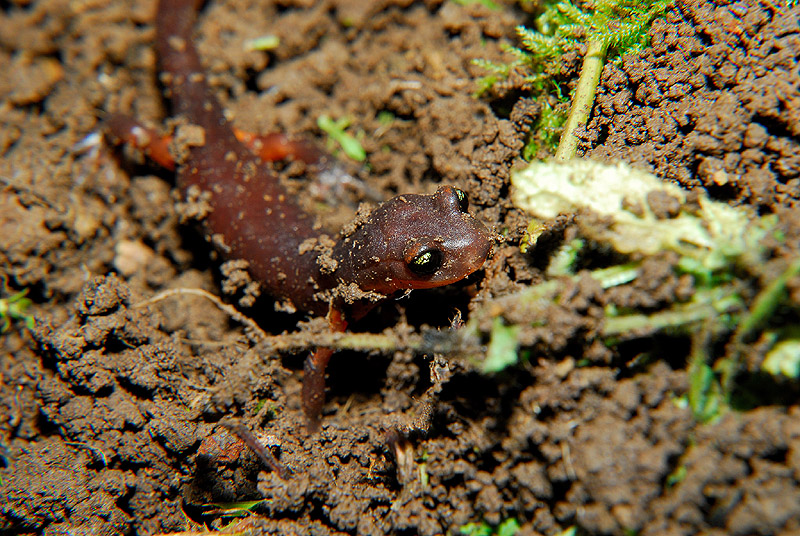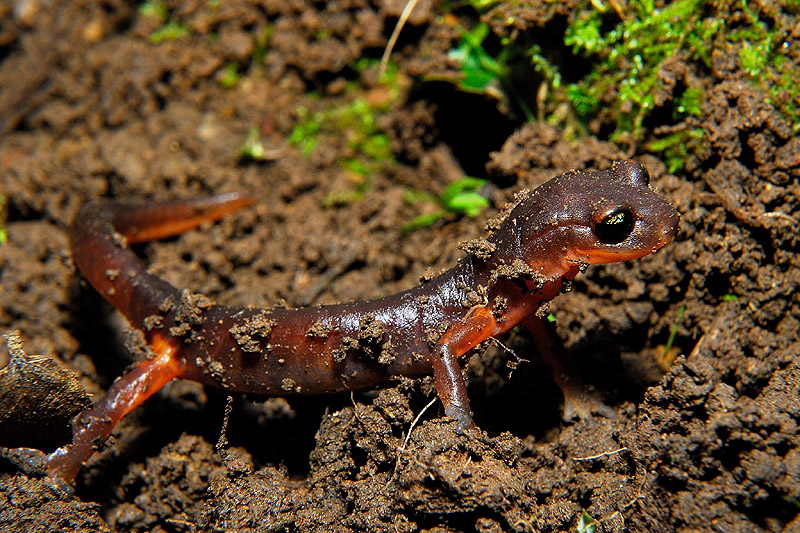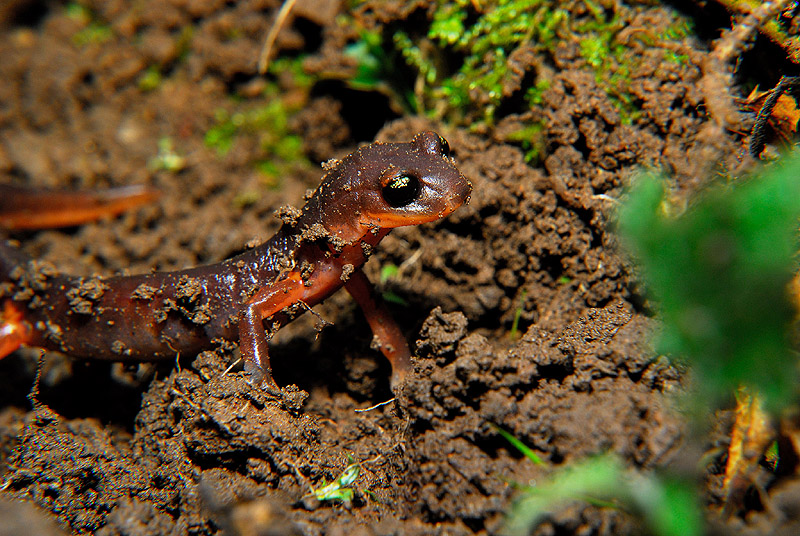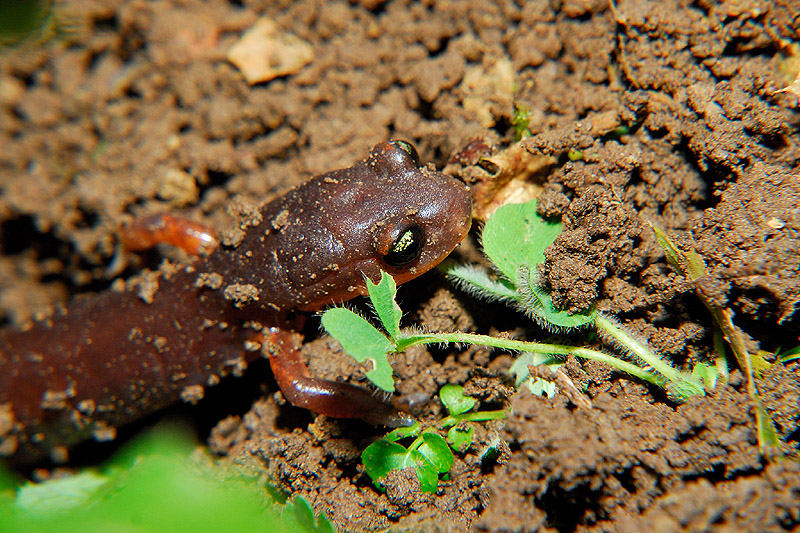This week the rain finally stopped, so we’ve been out in the orchard trying to get on top of the weeds, and plant out some more fruit trees (more on that later). This should have been a post about planting, but much like a magpie, I’m easily distracted in the garden. Mr. Curbstone had a shovel in hand, digging a hole for one of our new fruit trees. As his shovel plunged into some loose soil, a glint of salamander-orange caught my eye.
I was afraid to look. At first I thought this little fellow might have just met his demise at the end of the shovel’s blade, but once we turned him right side up we could see he was fine.
At first glance I thought this was another of our ubiquitous Coast Range Newts. This salamander is very similar in coloration, brown above, and orange below, but noticeably smaller than most of the adult newts we see here. A juvenile perhaps? Something didn’t look quite right though. The skin was too smooth, the body shape seemed different, and the behavior of this salamander seemed a little out of the norm too.


Coast Range Newts, once spied through a camera lens, have a tendency to scrabble under the nearest leaf, rock, or log. They’re very shy. This one though just stood tall, staring me squarely in the eye. It was difficult to tell who was more fascinated with whom!
I apologized to the little chap for such a rude and violent unearthing, and promised that after just one more, oh maybe two, well…if you’re just going stand there and cooperate…a few more photos, he could wander off on his merry way.
The longer we stared at each other though, the more I was convinced this salamander was different. Clearly not a California Slender Salamander, as those look like worms with legs. Not a Coast Range Newt either as his skin just wasn’t bumpy enough, and his body shape was much more slender, more like our recently discovered Arboreal Salamanders. There were no spots on this salamander’s skin though, so that ruled him out.
After downloading the photographs from our brief encounter in the orchard, I went back to the range maps at the California Herps website (after we finished planting the tree, it’s a struggle sometimes, but I try to stay on task), to determine which species of salamander are endemic here.


I confirmed this salamander to be a Yellow-eyed Ensatina (Ensatina eschscholtzii xanthoptica), which now brings our total to four salamander species in residence on the property (that we know of). It shouldn’t really be a surprise I suppose, as we do have the creeks, and more water running off the mountain this time of year than any damp-loving creature could ever hope to have. In the past few weeks, moist skin, webbed toes, or a snorkel have become almost required attire!
The Yellow-eyed Ensatina is the most abundant species of lung-less salamander in this region (and yet the last to be sighted here), that ranges from Healdsburg California, south to Santa Cruz County.
However, we’re located within an inter-grade zone here, where two species of Ensatina have ranges that overlap, the Yellow-eyed Ensatina, and the Monterey Ensatina.
The most readily apparent visual difference between the two species is that the Monterey species has dark eyes, with no yellow coloration in the eye, and as yet we haven’t seen a Monterey Ensatina on the property. Ensatinas, like all of our other salamander species here, thrive in cool moist environments. So how is it we’ve never seen this species previously? Like the Arboreal Salamanders, the Ensatinas are also most active on cool, rainy nights. As I make it a rule never to work nights, we’ve never encountered each other before.
Ensatinas measure between approximately 3-6 inches in total length, and are believed to live for upwards of 15 years. This species resides in moist evergreen and deciduous woodlands, coastal sage-scrub, chaparral and mixed-grassland areas.
Like the Coast Range Newt, the adults are brown dorsally, and orange ventrally, with a yellow reflective patch on the eye that gives this species its name.
This species has a diet similar to the Arboreal Salamander, including crickets (we’ve had no shortage of those in the orchard), centipedes, snails, spiders and termites (also abundant here).


This species breeds, on land, both in the spring and in the fall, and in some milder areas throughout winter. Females lay on average between 9-16 eggs under rotting bark, inside logs, or inside animal burrows.
This is not a migratory species of salamander, unlike the Coast Range Newt, and in fact, Yellow-eyed Ensatinas have quite limited movements. A study by Staub et al., in 1995 demonstrated that the home range of male Ensatinas was a mere 10-41 meters.[2] That would imply if they’re living here at Curbstone Valley, they likely stay here, and don’t wander far. This individual might never even range out of our orchard!
That being true, next time we’re planting trees in the orchard, we’re going to have to be more careful with the shovel! I can’t help it, isn’t that the most adorable salamander face you’ve ever seen?
—————-
[2] Staub, N.L., C.W. Brown and D.B. Wake. 1995. Patterns of growth and movements in a population of Ensatina eschscholtzii platensis (Caudata: Plethodontidae) in the Sierra Nevada, California. Journal of Herpetology 29:593–599



Oh, my! That was HEAVEN. What a magically beautiful creature!! I’ve never seen one before–such HUGE, dark eyes! Charm on charm on charm. (sigh) Thanks SO much for sharing.
Isn’t he gorgeous? I had to share, glad you enjoyed it!
Cool! I saw my first yellow-eyed Ensatina the week before Christmas. I’ve linked to this post.
I dropped by to visit your Ensatina post, I didn’t realize you found one too!
From the look of him, I think he actually believed he could take you. 🙂 How adorable!!
He did have that air about him, and really stood his ground! Very brave little guy!
That is a strangely cute salamander.
That is a very cooperative salamander indeed to allow you to take photos of it in all angles. I’m definitely not nuts about lizards but sometimes the more we look at something, the cuter they seem. I posted on a garden lizard a few months back and really thought it looked cute too. 🙂
It does help to have a very cooperative subject in front of the camera. I couldn’t believe how long he just stood there. As soon as I stepped back though, he started to crawl away.
Aw, what a neat encounter. I hope you keep plenty of places for him to hide in your orchard!
i used to see salamanders all the time in the PNW. But never one so big as the Pacfic Giant, that thing was HUGE!
We keep a number log and brush piles around the periphery of the orchard, which our salamanders, and our lizards all seem to appreciate. It’s amazing who you can find lurking under logs! I haven’t seen any of the Pacific Giant salamanders here, yet, but will keep watching out for them as we are located within their habitat range here.
Another delightful, informative AND funny post! Thanks for your blog CV…
You’re welcome Susan, glad you enjoyed it 🙂
Hi CV,
Lovely photos of such a cute little guy! So gorgeous!
You took the words right out of my mouth. When I saw the first image and click to make it bigger….adorable.
He just had such a friendly looking face. Maybe that insurance company should switch from a gecko to a salamander 😛
What a handsome fellow and such a distinguished name! Happy New Year to all of you….
YES. It absolutely is the most adorable salamander face I’ve ever seen. His “stare-down” tactic is so endearing, too! What a cool find! I’ve dug up some snakes before, and once a toad, but we’re at the very top of a tall hill and it gets too dry in my yard for most of the amphibians.
It gets very dry here in summer, especially on the orchard slope, but the creeks are just at the base of the slope so I suppose they find enough moisture down hill to be happy. I don’t irrigate most of the slope (except for drip irrigation around the trees).
Aw, I love that little guy! 🙂
I’m glad you didn’t kill him with your shovel. I’ve accidentally killed one toad and one skink with my shovel before, not realizing they were burrowed in the dirt, and I felt HORRIBLE about it. Still do lol.
I was so relieved. He was laying there upside down after the shovel hit the dirt, I was sure he’d been squished. He might have been a little dizzy and disoriented, but otherwise was unscathed, and a very very lucky salamander!
Fantastic photos. I concur, this little guy is darned cute. So glad he didn’t meet his end with the shovel.
Me too! Besides, he was fun to photograph!
Isn’t it fun to find confirmation in some characteristic that seems pretty arbitrary, until you read it’s official (like “standing tall”)? And yes, he’s cute as pie.
Reading that they do stand tall in their defensive post really did help to confirm that this little chap wasn’t one of the salamanders we’d seen before. The behavioral difference compared to our Coast Range Newts was really apparent!
Cutest salamander ever! What great pictures and it was interesting learning about them.
The termite I had to quickly scroll past though, we see lots of them flying around at the end of summer and they really creep me out. 🙂
Sorry about the termite Catherine. We see lots too, both dry wood and damp wood termites. I’m glad we have some natural termite control here with some of our salamander species!
Aside from water, etc., you must have an unpolluted and chemical free property as amphibians are very sensitive to pollutants (and hence they are going extinct faster than other groups). I always view finding a salamander on my property as an environmental seal-of-approval. how special to have four kinds.
You’re right Carolyn, amphibians are much more sensitive to pollutants in their environment that most other species. I do like to think that the large number of salamanders here indicates that we’re achieving at least some sense of balance with our gardening methods. We don’t use chemical fertilizers, or herbicides here. I consider seeing these creatures across the property part of our reward for our efforts, and I’m happy they’re here 🙂
Dear Clare, I am so relieved this cute little guy was not guillotined! We have lots of salamanders but yours is definitely the most handsome I’ve seen. Wishing you a happy and healthy gardening year! P x
Amazing. Those are great photos. And 4 species of salamander, that sounds almost too good to be true. I’m so glad you’re not using pesticides, the little guys are so sensitive…
Happy Friday (how’s Frodo?)
What a feisty fellow – a heart as large as his name. Just shows that size isn’t everything! Lucky that he escaped the spade.
Have a good weekend.
As always, great post. I always like finding salamanders. They’re cute and useful in eating pests. You’re lucky to have (at least) 4 species crawling around your property.
Amazing photos of an amazing creature! I confess I haven’t gotten around to trying to identify our local amphibians or reptiles. I do see lizards and frogs, but I am guessing we would have more if we had a better water source. The back part of our property is wild and swampy, but I rarely spend any time there.
I can’t pronounce his full name and couldn’t guess what in the world you were blogging about before I started reading, but your little salamander has enormous personality – so I guess he deserves a big name! Those eyes have completely taken me in; I’m so glad your shovel spared him!
I guess this bears repeating, but this guy is pretty darned cute!
Hi Clare, yes, truly a cutie. My daughter would be oohing and ahing at those big eyes. Congratulations to you for having the kind of place that nurtures four kinds of salamander. I would be afraid though, too, of spading now.
I am constantly amazed, and a bit jealous, I have to admit, at all the incredible wildlife you enjoy. That salamander is beautiful! The animal I encounter the most is the “Get-off-the-road-so-I-can-drive-while-drinking-a-latte-talking-on-my-cell-and-yelling-at-my-kids” minivan maniac. I think they might be the state animal here. I’ll have to double check.
If I had to guess what the title referred to I would have said a desert plant. Never imagined it was just a big name for a cute little fella/girl. Must be the Bambi of the salamander world. Fantastic info as always Clare.
Terrific information and amazing photos as always, but I’m laughing at the idea of poor Mr. Curbstone standing there with a shovel while you lay in the dirt taking pictures. That’s a great lifestyle. 🙂